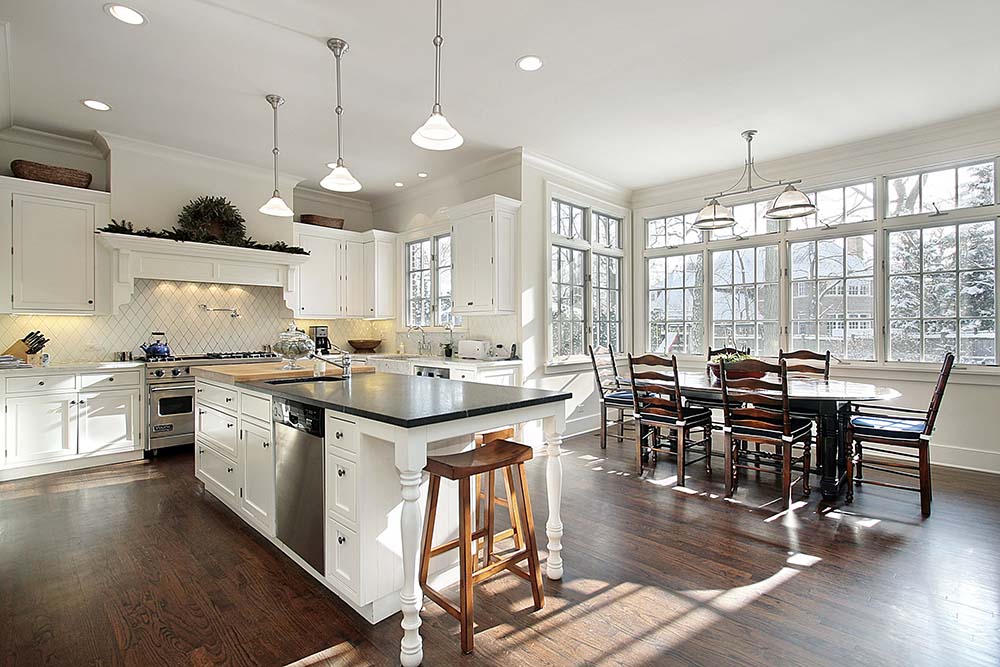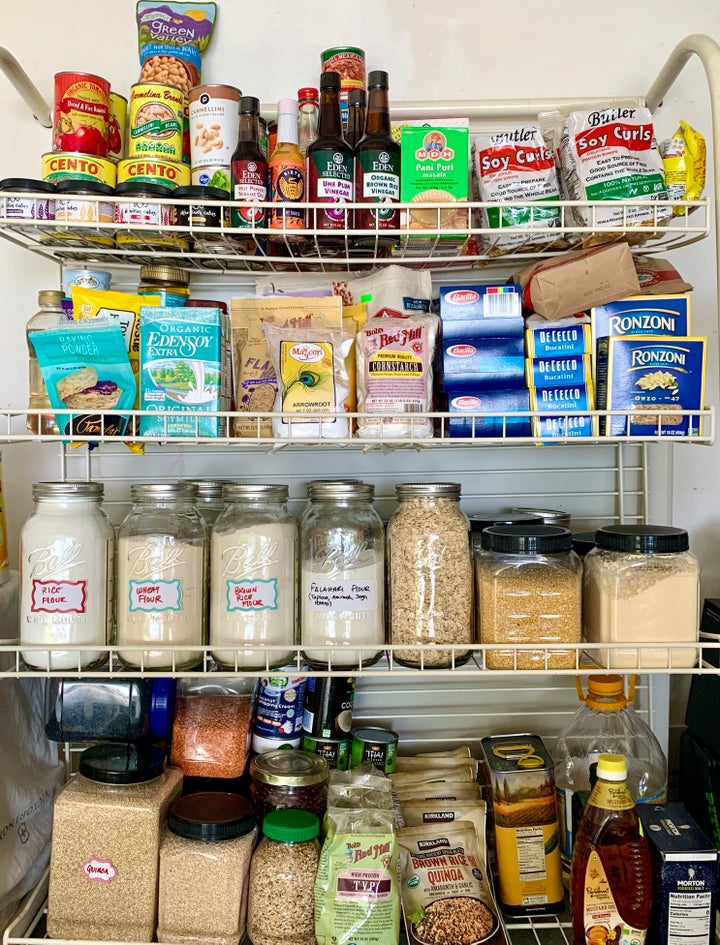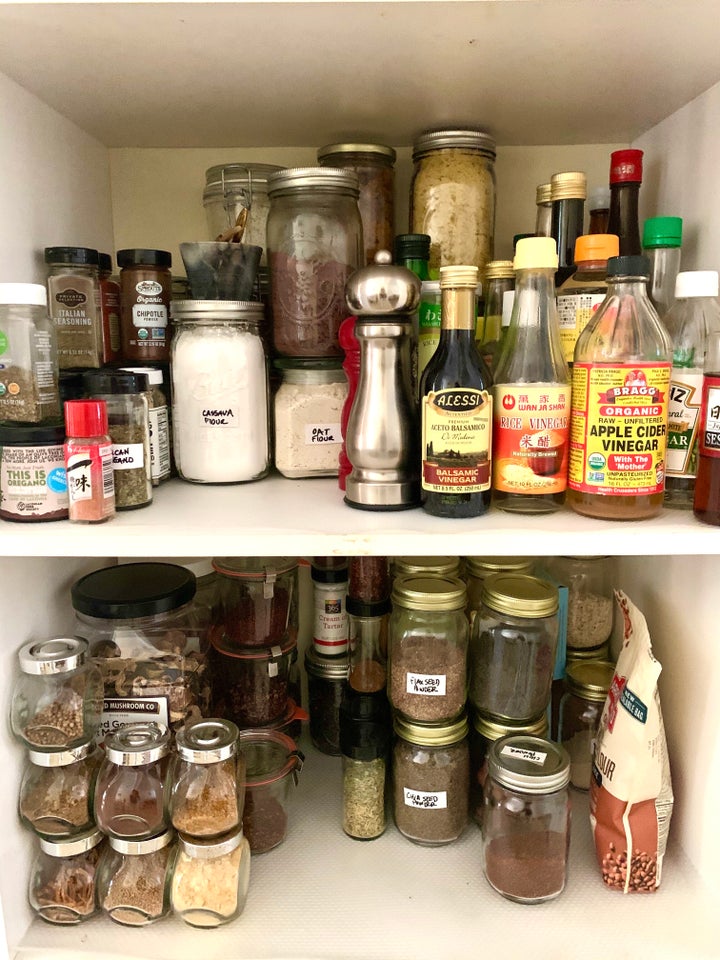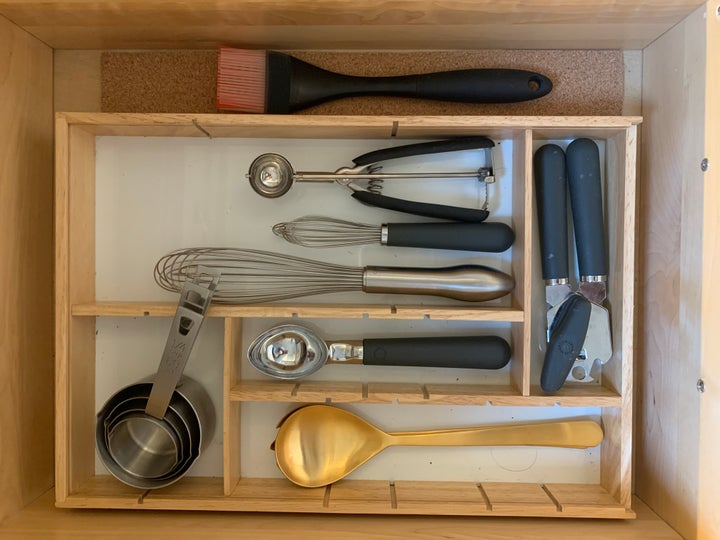
6 Easy Ways To Organize Your Kitchen That’ll Make Cooking Less Stressful
Whether you’re following a new recipe, preparing multiple dishes at once or simply desire to cook in a clean, stress-free environment, organization is key.
With so many of us in the kitchen more than ever — baking banana bread, tending to sourdough starters, cooking one-pot dishes — it’s time to make your kitchen space work for you and suit your needs. To help get you started, we asked professional chefs (who routinely work in compact, shared spaces where being organized is a necessity) to share organizational tips that they employ in their home kitchens.
1. Keep leftovers in sealed containers and store them where you’ll actually see them.
Cooking in bulk can be a great time-saving technique and cut down on the number of dishes to wash, but it’s important to keep track of leftovers so that they’re eaten before they go bad. “Leftovers should be stored in proper containers and visible in the refrigerator so they are not forgotten when the week gets busy,” Palak Patel, a chef at the Institute of Culinary Education, told HuffPost. She recommends using glass containers with tight-fitting lids, as those are best for keeping cooked leftovers fresher. “Dedicate a full shelf or separate half a shelf for cooked food, and the other half for raw and prep ingredients.”
2. Use a whiteboard to keep track of what’s in your fridge and freezer.
In a similar way, freezing homemade broths, sauces and prepared dishes for a later date can save time and cut down on food waste. Having an organizational system allows you to know what you have and actually use it.
“Have a system to keep frozen veggies stacked together, alcohol together and any broth, sauces or frozen entrees together with dates written on the freezer bags,” Patel said. “If the freezer is packed, try keeping a small checklist of what’s stored in the freezer with dates.” She uses a dry-erase board to keep track of what’s in her fridge and freezer (and easily see what needs to be used or eaten), plus items that need to be replaced.
3. Keep commonly used ingredients within easy reach, and get rid of what you don’t use.
It’s time to Marie Kondo your pantry, if you haven’t already. “Purge things you don’t need! Old herbs from a recipe you tried five years ago and you’ve never used again, expired items that you haven’t had the heart to throw away ― toss it all!” said Uyen Kirshenbaum, a pastry chef and founder of Kirsh Baking Company. “Clearing up your cupboards and organizing ingredients alone will make you more efficient. Bring ingredients you use most and those with a shorter shelf life to the front.”
 Palak Patel
Palak PatelIt may be tempting to keep commonly used cooking oils and ingredients near the stove for even easier access, but the heat can negatively affect the shelf life and quality of these products. “I keep spices, olive oil and other delicate ingredients in a separate area farther away from the stove in a cool, dry place.” Patel said.
4. Organize pantry ingredients based on how you use them.
In addition to keeping your most-used cooking oils and spices within reach, it can be helpful to keep baking ingredients separate from savory cooking ingredients and even further subdividing based on cuisine. Patel separates her baking ingredients from Indian spices, and dried peppers from nuts. “For other ingredients, separating by cuisine helps me grab ingredients easily for a recipe,” she said.
In addition to grouping similar ingredients together, Patel uses small, inexpensive glass jars that keep things uniform. Since they’re stackable, they also allow her to optimize cabinet space. “I also love labels and use them a lot!” she said.
 Palak Patel
Palak Patel5. Find a home for everything in your kitchen.
Ensuring that everything, from spices and cooking oils to knives and spatulas, has a designated place in your kitchen will help prepping, cooking and cleanup go seamlessly. “If you have to think about where something is, then it’s not organized effectively. You shouldn’t really even have to look — just grab whatever you need, because you know it will be there, clean and ready to use,” Qian Zhang, owner of The Dumpling Lady (a Charlotte, North Carolina-based food truck with a stall in Optimist Hall), told HuffPost. “As long as everyone using the kitchen is on the same page about this, it should operate pretty smoothly.”
As you find the perfect place for each item in your kitchen, consider parting ways with things like single-use gadgets that take up precious storage space. Kirshenbaum noted that items like electric can openers, garlic presses and egg choppers take up space and require more time to use and clean. “Invest in one favorite knife that can do the job,” she said. Of course, if these are well-loved tools in your kitchen or a necessity because of mobility issues, make sure these items find an appropriate storage spot.
 Palak Patel
Palak PatelIf after decluttering you’re still having trouble closing your drawer of kitchen utensils, consider storing them on the counter. “Canisters are your best friend!” Greg Rales, owner and baker of Red Gate Bakery, told HuffPost. “I have a couple and try to organize either by material (rubber, wood, metal) or by function (usually separating them between cooking and baking).”
“Try to organize things based on their function,” Rales said. “It can get easy to sort aesthetically (I, too, am guilty of this!), but the more you cook, the more you know what you use most frequently. You can make the best use of your time in the kitchen by sorting your tools based on what you use the most, and for what purpose.”
6. When it’s time to cook or bake, there are only three words you need to remember: mise en place.
A French phrase which translates to “everything in its place,” mise en place is the process of preparing the ingredients in a recipe before you start cooking. Just think about what it looks like when you watch a cooking show, and the chef already has all their vegetables chopped up in nice little glass bowls.
“Mise en place is super helpful before starting a recipe and will make everything come together so much more quickly,” Rales said. “Get all of your chopping, measuring and prep done before starting to actually cook and you’ll get through it in a breeze.”
Calmly preparing and measuring everything you need before you turn on your stove or oven ensures you’re not scrambling to find an ingredient and paying attention to the task at hand. This means less mistakes in the kitchen and a more zen environment while preparing food.
Leave a Reply Cancel reply
You must be logged in to post a comment.

1 comment
Pingback: Using Social Media to Inspire Your Decor Choices – Betty Most Real Estate | River Falls Real Estate Agent